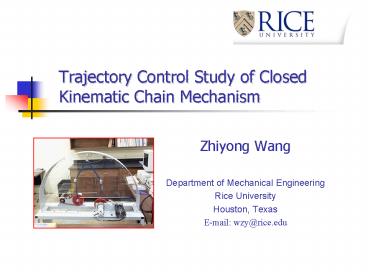Trajectory Control Study of Closed Kinematic Chain Mechanism
1 / 14
Title:
Trajectory Control Study of Closed Kinematic Chain Mechanism
Description:
... the Lagrange Multipliers and obtain the equations of motion in terms of (q', q) ... Real-time Computation of q'= (q) . Rate of convergence. Simplicity of ... –
Number of Views:71
Avg rating:3.0/5.0
Title: Trajectory Control Study of Closed Kinematic Chain Mechanism
1
Trajectory Control Study of Closed Kinematic
Chain Mechanism
- Zhiyong Wang
- Department of Mechanical Engineering
- Rice University
- Houston, Texas
- E-mail wzy_at_rice.edu
2
Introduction Serial Robot vs. Parallel Robot
- Serial Robots
- Links are connected sequentially by revolute,
prismatic or spherical joints. - Typically, all the joints of serial robots are
actuated.
- Parallel Robots
- Links are connected in series as well as in
parallel combinations forming one or more
closed-link loops. - Typically, not all the joints of parallel robots
are actuated.
3
Introduction Advantages of Parallel Robots
- Lighter moving parts, hence greater efficiency
and faster acceleration at the end-effector. - For closed chain mechanisms, the actuators are
typically placed closer to the base or on the
base itself. - Greater rigidity to weight ratio
- Smaller positioning errors due to the
multi-support of the end-effector. - Greater payload handling capability for the same
number of actuators. - Applications
- Fast assembly lines
- Flight simulators
- Robotic machining.
4
Challenges In Modeling Control of
Closed-chain Mechanisms
- Unlike open-chain mechanisms, the derivation of
dynamic equations of motion for closed-chain
mechanisms suitable for controller design is
still a active research area. - Basic requirement of mode based controller
design - The system under study is described by a set of
explicit ODEs, i.e. the number of differential
equations is equal to degrees of freedom. - Facts in modeling of closed-kinematic chain
mechanisms - The implicit nature of the loop-equations make
it prohibitive to obtain explicit equations of
motion for general close-chain mechanisms.
Typically they are represented by system of DAEs. - Domain of definition of generalized coordinates
is a subset of the whole n-dimensional real space.
5
Derivation of a Reduced Model (I)
- Standard model for open-chain mechanisms
explicit ODEs - where n?n inertia matrix
- the n?n centrifugal and Coriolis terms
- the gravity vector
- applied torque at actuated joints
- Basic idea of model reduction
Free System ? Constrained System (ODEs)
(DAEs)
?
Constraints ? Lagrange Multiplier ?
6
Derivation of a Reduced Model (II)
- By considering the virtual work associated with
the dynamics of the constrained system and
assuming a workless constraint, we can eliminate
the Lagrange Multipliers and obtain the equations
of motion in terms of (q, q) - where
- and
7
Derivation of a Reduced Model (III)
- Now the equations of motion of the constrained
system can be expressed in terms of independent
generalized coordinates as - by combining
- where the parameterization q?(q) can be
obtained from the constraint equations
(loop-equations). - The existence of ?(q) is insured by the implicit
function theorem and it is in general implicit,
therefore the Reduced Model is a implicit model.
8
Trajectory Control Implementation on the RPDR (I)
- Hardware environment
- Rice Planar Delta Robot (RPDR)
- dSPACE 1102 board
- Capable of computing the control law within 500
us. - ¼ hp Bodine 4435 DC motor with an output torque
of 100 Oz-in for continuous operation at 2500 rpm - Hengstler Optical Encoder with a resolution of
10,000 pulses per revolution - Links made of square, hollow steel tubing provide
a high stiffness to weight ratio.
9
Trajectory Control Implementation on the RPDR (II)
- Trajectory Planning Inverse Kinematics.
- Selection of a singularity-free-region.
- Computation of desired position, velocity and
acceleration.
10
Trajectory Control Implementation on the RPDR
(III)
- Real-time Computation of q?(q) .
- Rate of convergence.
- Simplicity of algorithm implementation.
Original formulation of Newton-Raphson iterative
algorithm for nonlinear algebraic
equation Intermittent initialization
algorithm Where is updated at a
lower frequency than the sampling frequency.
11
Trajectory Control Implementation on the RPDR (IV)
- Inverse dynamics control law
- where
- and
12
Trajectory Control Implementation on the RPDR (V)
- Experimental Results
Tracking Results with Initialization frequency
100 Hz
Tracking Results with Initialization frequency
1000 Hz
13
Trajectory Control Implementation on the RPDR (VI)
- Experimental Results (cont.)
Tracking Results with Initialization frequency 10
Hz
Tracking Results with Initialization frequency 20
Hz
14
Conclusion
- The trajectory control of RPDR is based on a
implicit Reduced Model, thus the real-time
computation of the parameterization q?(q) is a
prerequisite to the implementation of the control
law, which necessitate an effective numerical
algorithm. - In tracking control the effect of friction can
not be ignored. More sophisticated model
including friction shall improve the tracking
results. - The establishment of stability property of the
inverse dynamics control law will be a useful
extension of this work.































